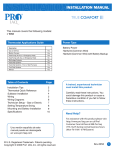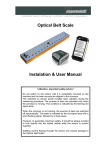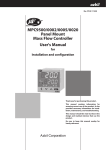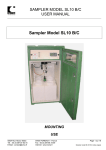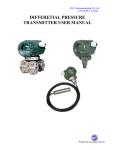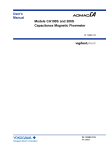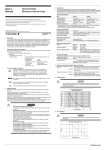Transcript
User's Manual B Model 701920 Differential Probe for DL Series C D A E F G Thank you for purchasing the YOKOGAWA 701920 Diffrential Probe. To optimize all the functions of the instrument, please read the manual thoroughly before operating it. A Disk No. DL06 1st Edition : April 2001 (YK) All Rights Reserved, Copyright © 2001, Yokogawa Electric Corporation IM 701920-01E 1st Edition Safety Precautions Make sure to comply with the safety precautions mentioned hereafter when handling the probe. YOKOGAWA ELECTRIC Co. assumes no responsibility for any consequences resulting from failure to comply with these safety precautions. Also, read the User's Manual of the measuring instrument thoroughly so that you are fully aware of its specifications and handling, before starting to use the probe. 4 J H Connector pin arrangement of the power supply cable NC 1 2 COMMON +12V I K L 3 –12V Differential probe Optional Accessories Part No. Name Accessories for B to L B9852SZ Differential probe Standard Accessories Name Qty B Single pin 6 C Twin pin adapter (sml) 2 D Twin pin adapter (lg) 2 E Connection lead, red (long) 1 F Connection lead, black (long) 1 G Connection lead, red (short) 1 H Connection lead, black (short) 1 I Pincher tip, red (sml) 1 J Pincher tip, black (sml) 1 K Pincher tip, red (lg) 1 L Pincher tip, black (lg) 1 General definitions of safety symbols and markings Protective grounding terminal. Danger. High voltage. This symbol calls attention to a procedure, practice, condition or the like, which, if WARNING not correctly performed or adhered to, could result in injury or death of personnel. This symbol calls attention to a procedure, practice, condition or the like, which, if CAUTION not correctly performed or adhered to, could result in damage to or destruction of part of the product. Make sure to comply with the following safety precautions in order to prevent accidents such as an electric shock which impose serious health risks to the user and damage to the instrument. WARNING WARNING • Grounding of the measuring instrument The protective grounding terminal of the measuring instrument must be connected to ground. • Connecting the object of measurement Make sure to avoid an electric shock when connecting the probe to the object of measurement. Do not remove the probe from the measuring instrument after the object of measurement is connected. • Do not operated with suspected failures If you suspect that there is damage to this probe, have it inspect by a service personnel. • Nondestructive input voltage range Do not apply any voltages exceeding ±40 V(DC+AC peak) between input and earth. • Must be grounded Before connecting the input terminal of the probe to the object of measurement ensure that the measuring instrument is properly grounded and that the probe's output connector is attached to the BNC connector of the measuring instrument. • Do not operate without cover To avoid electric shock or fire hazard, do not operate this probe with the cover removed. • Do not operate in wet/damp conditions To avoid electric shock, do not operate this probe in wet or damp conditions. • Do not operate in explosive atmosphere To avoid injury or fire hazard, do not operate this probe in an explosive atmosphere. • Avoid exposed circuitry To avoid injury, remove jewelry such as rings, watches, and other metallic objects. Do not touch exposed connections and components when power is present. CAUTION 3. Specifications Input type Frequency bandwidth Attenuation ratio Output offset voltage Differetial input voltage range Common mode input voltage range Nondestructive input voltage range Input resistance(typical value) Input capacity(typical value) CMRR(typical value) External dimensions Total cable length Weight Operating temperature Operating humidity Storage temperature Storage humidity Power supply voltage Power supply current EMC Balanced differetial input DC-500 MHz for probe *1 10 : 1 ±3% when connected to a resistance of 50 Ω ±1% *1 ±5 mV(±50 mV when converted into input terminal) *1 ±12 V ±30 V ±40 V(DC + AC peak) *2 100KΩ(relative to ground) 2.5pF(relative to ground) 60dB(1MHz), 17dB(500MHz) 111 mm × 22 mm × 14 mm(excluding cable and accessory) 1.2 m(probe cable) 1 m(power supply cable) Approx. 130 g 5 to 40 °C 25 to 85% RH(no condensation) –20 to 60 °C 25 to 85% RH(no condensation) ±12 V ±1V(Usable range: 11 to 13 V or –11 to –13 V) Current of the power supply terminal is less than 125 mA Complying standard : EN55011 : 1998(Class B) EN61000-3-2 : 1995/A1/A2:1998 EN61000-3-3 : 1995 EN50082-1 : 1997 *1 Reference operation conditions: Ambient temperature 23 ± 5°C; Ambient humidity 55 ± 10%; 30 minutes after the power supply is applied. *2 For the relation between frequency and input voltage derating see the graph below. Relation between frequency and input voltage derating. 100 Nondestructive input voltage range (V peak) This symbol indicates the risk of injury, death of personnel, or damage to the instrument. 40 10 1 1 10 1000 100 Frequency (MHz) 4. Operation 1. Connect the power supply probe of the product to the power supply connector of DL series or to 700938. 2. Simply plug-in the BNC output connector to the vertical input of a oscilloscope. In this case set the input resistance of the oscilloscope to 50 Ω. 3. Using the appropriate probe accessories, connect the input to the circuits under measurement. • Nondestructive input voltage range Do not apply any voltages exceeding the Nondestructive input voltage range to the probe. • Use proper power source Use the power supply connector for the probe of DL series or use the 700938 power supply. Do not operate this probe from a power source that applies more than the voltage specified. WARNING • To protect against electric shock the ground side of the output cable (the shielded side of the BNC connector) must be grounded. • When disconnecting the BNC connector, always first separate the probe from the high voltage parts of the circuit under measurement. Terms appear in this manual Note CAUTION Provides information that is important for proper operation of the instrument. Use a soft cloth to clean the dirt. Prevent damage to the probe. Avoid immersing the probe. Avoid using abrasive cleaners. Avoid using chemicals contains benzene or similar solvents. 1. Description The 701920 Differential Probe is an active probe with a frequency bandwidth of 500 MHz and attenuation ratio of 10 : 1. 2. Appearance As shown in the following illustration, the probe consists of a main body and standard accessories. Note Accurate measurement may not be possible near objects with strong electric fields (like cordless equipment) or strong magnetic fields (like transistors or large current circuits). IM 701920-01E 1st Edition
